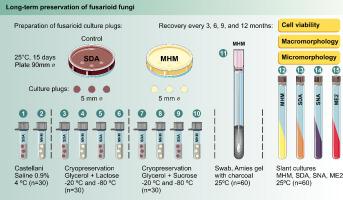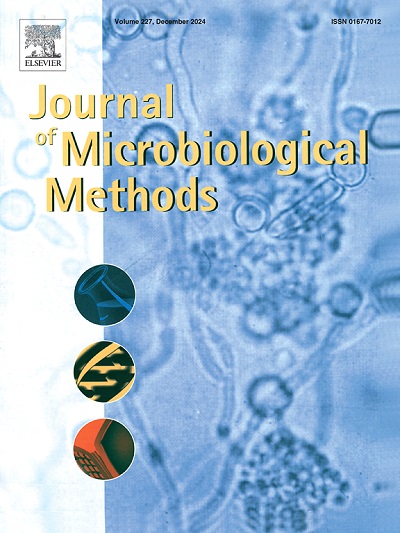A simple culture medium for phenotypic characterization and long-term storage of medically relevant fusarioid fungi
IF 1.9
4区 生物学
Q4 BIOCHEMICAL RESEARCH METHODS
引用次数: 0
Abstract
Fusarioid fungi, particularly Neocosmospora solani and Fusarium oxysporum, are emerging as significant human pathogens, causing infections ranging from localized mycoses to life-threatening systemic diseases. Accurate identification and preservation of these fungi in clinical laboratories remain challenging because of their diverse morphologies and specific growth requirements. This study evaluated a novel milk-honey and malt agar (MHM) against conventional media for cultivating and preserving 60 clinical fusarioid isolates, including Neocosmospora spp. (n = 47), Bisifusarium spp. (n = 5), and Fusarium spp. (n = 8). Compared with Sabouraud dextrose 2 % agar (SDA) and malt extract agar (ME2), MHM significantly increased conidia production (p < 0.0001, mean = 3.4 × 103, standard deviation (SD) = ±1.3 × 103), with results similar to those of carnation leaf agar (CLA). MHM facilitated superior preservation of fusarioid viability for up to one year at room temperature on slant cultures and over two years on swabs in Amies gel with charcoal, outperforming current methods such as Castellani (water) or cryopreservation. Morphological characterization of fusarioid fungi grown on MHM revealed distinct growth patterns and conidial structures for Neocosmospora, Bisifusarium, and Fusarium species, aiding in identifying these genera. The superior performance of MHM in stimulating conidiation, maintaining viability, and preserving morphology underscore its potential as a reference medium for medically relevant fusarioid fungi, with broad implications for clinical mycology laboratories and resource-limited settings.

一种用于表型鉴定和长期储存医学相关真菌的简单培养基。
镰刀菌类真菌,尤其是新孢子菌(Neocosmospora solani)和氧孢子菌(Fusarium oxysporum),正在成为重要的人类病原体,可引起从局部真菌病到危及生命的全身性疾病等各种感染。由于这些真菌形态各异,对生长有特殊要求,因此在临床实验室中准确识别和保存这些真菌仍具有挑战性。本研究评估了新型牛奶蜂蜜麦芽琼脂(MHM)与传统培养基在培养和保存 60 株临床镰刀菌分离物方面的差异,包括新孢子菌属(n = 47)、双孢子菌属(n = 5)和镰刀菌属(n = 8)。与 Sabouraud dextrose 2 % 琼脂(SDA)和麦芽提取物琼脂(ME2)相比,MHM 显著提高了分生孢子的产量(p 3,标准偏差(SD)= ±1.3 × 103),其结果与康乃馨叶琼脂(CLA)相似。在室温下,MHM 可使斜面培养物上的镰刀菌存活率保存长达一年,在含木炭的 Amies 凝胶中的拭子上保存两年以上,优于卡斯特拉尼(水)或低温保存等现有方法。在 MHM 上生长的真菌的形态特征显示了新孢子菌属、双孢子菌属和镰刀菌属的独特生长模式和分生孢子结构,有助于确定这些菌属。MHM 在刺激分生、保持活力和保存形态方面的优越性能凸显了它作为医学相关真菌参考培养基的潜力,对临床真菌学实验室和资源有限的环境具有广泛的意义。
本文章由计算机程序翻译,如有差异,请以英文原文为准。
求助全文
约1分钟内获得全文
求助全文
来源期刊

Journal of microbiological methods
生物-生化研究方法
CiteScore
4.30
自引率
4.50%
发文量
151
审稿时长
29 days
期刊介绍:
The Journal of Microbiological Methods publishes scholarly and original articles, notes and review articles. These articles must include novel and/or state-of-the-art methods, or significant improvements to existing methods. Novel and innovative applications of current methods that are validated and useful will also be published. JMM strives for scholarship, innovation and excellence. This demands scientific rigour, the best available methods and technologies, correctly replicated experiments/tests, the inclusion of proper controls, calibrations, and the correct statistical analysis. The presentation of the data must support the interpretation of the method/approach.
All aspects of microbiology are covered, except virology. These include agricultural microbiology, applied and environmental microbiology, bioassays, bioinformatics, biotechnology, biochemical microbiology, clinical microbiology, diagnostics, food monitoring and quality control microbiology, microbial genetics and genomics, geomicrobiology, microbiome methods regardless of habitat, high through-put sequencing methods and analysis, microbial pathogenesis and host responses, metabolomics, metagenomics, metaproteomics, microbial ecology and diversity, microbial physiology, microbial ultra-structure, microscopic and imaging methods, molecular microbiology, mycology, novel mathematical microbiology and modelling, parasitology, plant-microbe interactions, protein markers/profiles, proteomics, pyrosequencing, public health microbiology, radioisotopes applied to microbiology, robotics applied to microbiological methods,rumen microbiology, microbiological methods for space missions and extreme environments, sampling methods and samplers, soil and sediment microbiology, transcriptomics, veterinary microbiology, sero-diagnostics and typing/identification.
 求助内容:
求助内容: 应助结果提醒方式:
应助结果提醒方式:


